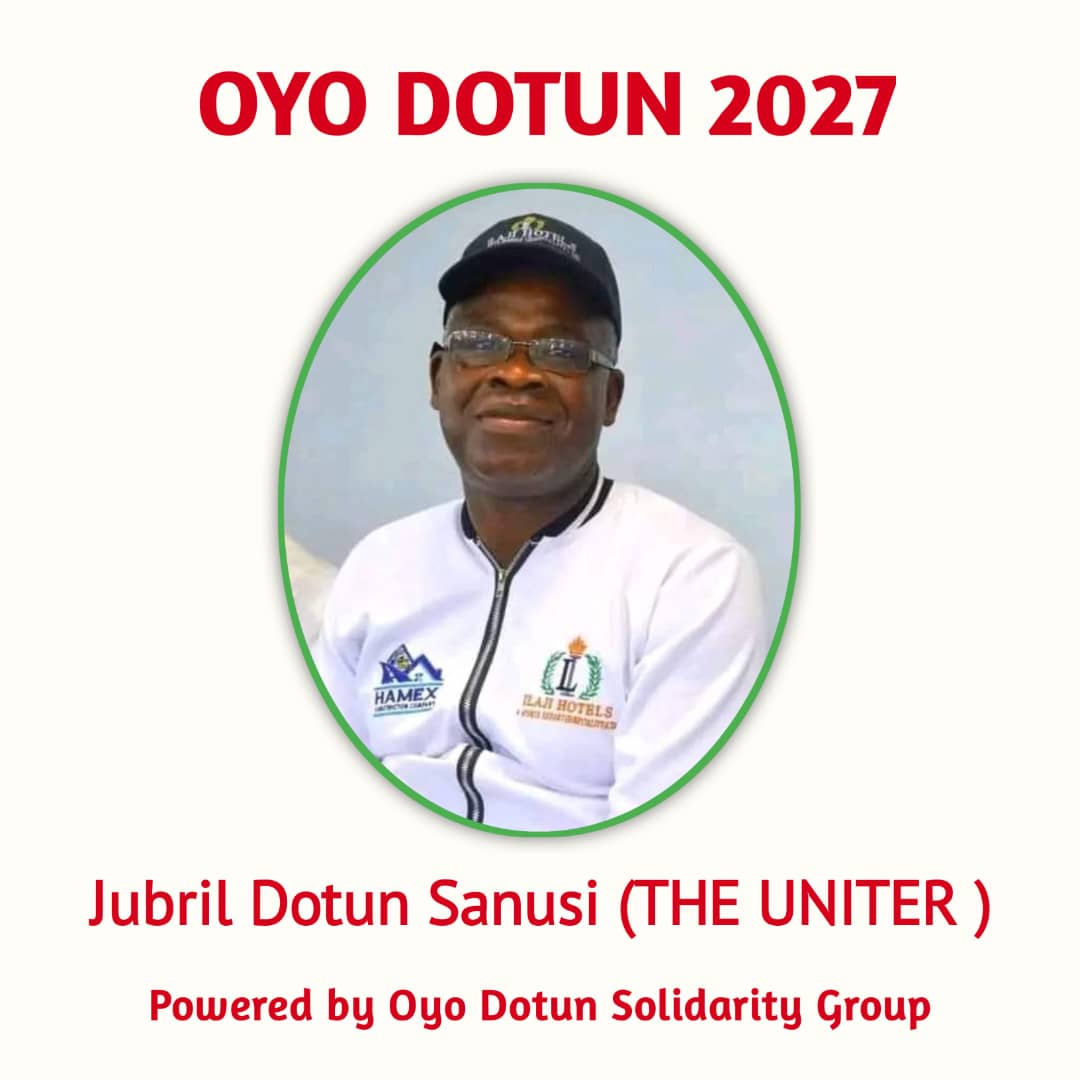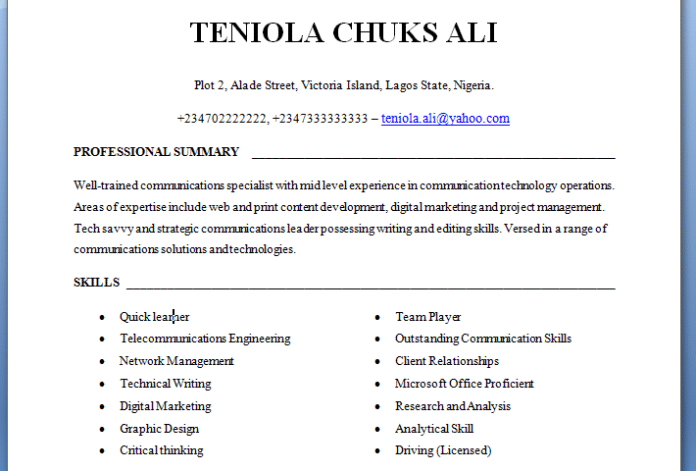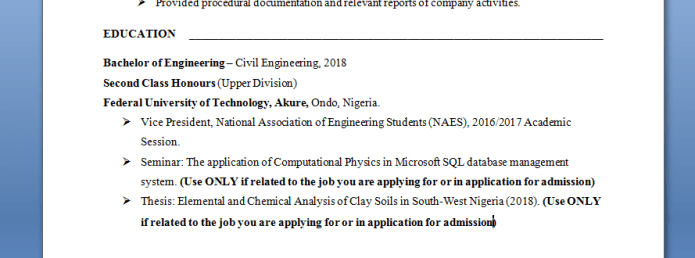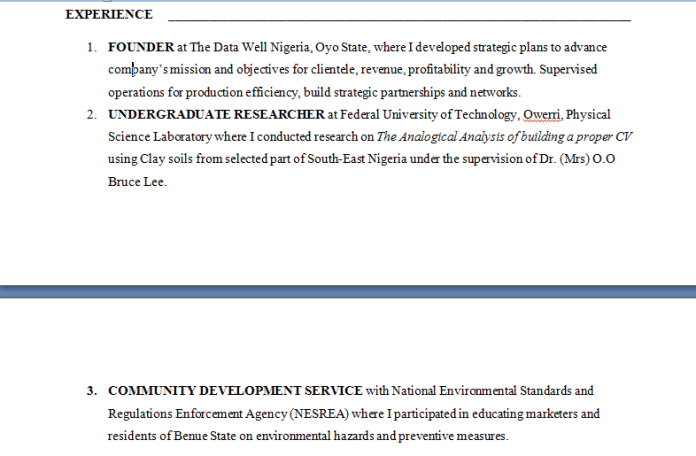A Curriculum Vitae (CV) is a brief presentation of your education, qualifications, experience and skills. It is the first point of contact with your potential employer and its contents will significantly affects the success of your Job Applications. A properly written CV should always get you to the interview stage of a recruitment process.
In this article, we will take a look at how to write an ideal CV for you next job application. Many job seekers make a common mistake of using a single single CV for each job applications, they just copy and paste the same CV designed for every job application. While this is not a crime, it can really affect the success of your application when you send a CV that displays no correlation with the job you are applying for.

In that regards, you must always prepare to edit your CV to suit the requirements and responsibilities of the position which you are applying for. But to achieve this, you should know the required contents that should appear in ideal CV and how to write them yourself.
THE IDEAL CV STRUCTURE
When you search “how to write an ideal CV” on google, you will be provided with a sophisticated amount of structures that your CV can have. These numerous options can be overwhelming and choosing the “right option” can become a job itself.
Do not stress yourself; choose a CV structure that you can design yourself using Microsoft Word or a design that someone could help you build easily. But be careful, if you are giving it out, do ensure you know how to edit it to change a few things when the need arises.
In this article, we will explore three (3) different structures that your CV can be composed. The Professional CV structures and the Academic CV Structure.
HOW TO WRITE AN IDEAL CV – STRUCTURE ONE (Recommended)
The CV used for the explanation was designed using the popular Microsoft Word Application. Below is the structural breakdown, how to design it and the required contents.
1. CV Heading
Your CV should start with your Full Name (First Name, Middle Name & Surname) boldly written preferably with larger font size to make it look very much distinct. Do not start your CV with “Curriculum Vitae” please, it is a common mistake. After your name comes your address.
QUICK TIP: If you are seeking for a job, please use an address that is in the location of the company you are sending your application to. If you are applying for a job in Lagos and you live in Porthacourt, find a friend or brother or cousin or anyone that lives in Lagos and apply using his/her address. This will make interviewers consider your application faster than living hundreds of miles away from the job.
After your address, write your contact details, phone number(s) and Email address. Please use only professional Email address. If your name is “Teniola Chidinma” use Email address that contains the combination of your names not Emails like tenisexy4u@gmail.com, this presents you as an unserious applicants and most importantly, unprofessional.
Emails like teniola.chidinma@gmail.com or teniola.chidinma01@gmail.com or any other form that represents your name perfectly is perfect.
Your heading should look like this;

2. CV Body
If your heading is properly written, you do not need to create any section called “Personal Data”. Information like Date of Birth, State of Origin and Nationality are not compulsory and in most cases, unnecessary except you are writing an Academic CV or specifically stated in the Application instructions.
If your age is more than the required age for the job, do not write your date of birth in your CV. I do recommend that you hide all those details and rather use the available space to promote your skills and capabilities. So, with “Personal Data” out, the first section of the body of your CV should be “Professional Summary” – In this section, you should try your best to summarize your experience and/or skill, achievements and foresight in a concise manner preferably between 3 – 5 sentences.
Your CV will by now look like this;

After you have written your Professional Summary, it is time to display your set of “Skills”. In this section, you should write your skills in word using a list structure. If you have a long list of skills, you can create a two column structure to make the structure organized and neat. See the image below;

Please do not write a skill that you do not have, write skills you have and those that you can defend. Also, do not be shy to display your skills, that is the whole essence of your CV. This is not the time to be “Humble”. Moving further, it is time to write your “Work History”. This is a very important section of your CV, it is the section where you are expected to write all your work history starting with the MOST RECENT. This section requires you to express “The Job Title/Position Held”, “The Work Duration (Month & Year)”, “The Company” and “Your Duties”.
The most tasking aspect of this section is your ability to enumerate “Your Duties/Responsibilities”. Whatever you write as your duties in the company will give the interviewer an insight of the kind of tasks you have carried out and will also allow him/her to compare them with your “Skills”. And most importantly, it allows him/her to be able to correlate it with the skills required for the Job you are applying for.
So, before you write, retrieve the “Job Description” of all the Jobs in your work history and write down the activities you carried out while working for the firm. If a job is in your job description, you have every right to include it in the duties that you carried out even if you were not totally involved, the fact is that you have in one time or the other been partially involved and you have a quality idea of what it entails.
So merge the activities in the Job description and the activities that are not in the Job description but you did as part of the Job. Put them together in quality paragraphs, this section should not be scanty. It should contain quality paragraphs showing the details of all the activities you carried out working in that role.
Please do not write anything that you cannot defend, many job applicants do make the mistake of bombarding their CVs with “lies”, they write duties that are not correlated to their skill set, once an interviewer spots a disorder, it can crumble the entire CV and nullify the whole reason for learning how to write an ideal CV. If you truly worked in the position that you are filling in, you should have more than enough “duties” that you can write. If you currently work in an organization, use present tense to write your duties, if you no longer work there, use past tense.
Also;
- Experiences gathered as Intern or during your 3 Months, 6 Months or 1 Year Internship as a student should be written with the word Trainee or Intern.
- If you have a long list of work history, write only the ones related to the job you are applying for to make your CV brief.
- Do not leave more than One Year unaccounted for in your work history. Fill it in, even if it is with Community Service Job or Volunteering or better still, account for that in the “Education or Certification Section”.
Check the image below to the structure of it should be written;


After the Work History section, write your “Education”. This section requires you to display all your educational qualifications, however do note the following;
- Education. Just input your Degree and the Year of Graduation.
- If you do not have a Degree, write your highest qualification and Year of Graduation.
Aside just writing your Educational Qualification and Year of Graduation, you can enumerate your giant strides as a student during the course of your study. See the image below;

After Education comes “Certifications and Awards”. Please do not skip this place if you are a fresh graduate, do as little as some online courses if you have not attended any training before. Online Courses, Trainings, etc especially those related to the job you are applying for should fill this section. If you have any awards, such as winning the MTN Scholarship or Shell/NNPC Scholarship etc as an Undergraduate, this is the section where you get to write it all. This section have tremendous effect on the value of your CV, it presents you as a resourceful person.

Then, input your Extracurricular Experiences such as your entrepreneurial endeavors, your undergraduate research, your National Youth Service and in fact, your Community Development Service (CDS). Create another heading “Experiences” and list all of your experiences.

And finally on the CV Body, the “Referees”. Referees should consist of people that can vouch for your capabilities, preferably people that are not directly related to you like family. However you can use reputable members of your family whom you believe their name commands respect in the country or is an expert in your field.
QUICK TIP: If you have a Governmental Connection, or someone that is either influential in the country or in the company that you are applying to, this is where you get to use his/her name. DO NOT HESITATE but ensure you inform him/her. Let them know how they can help you.
Another best practice is to use your previous employers as Referee and/or your Academic mentor in the University. This is a social proof that you have a good relationship with all those you have worked with.
Inform anyone you want to use as referee before using their names and ensure you are on “the same terms (I mean, be sure that you are friends)”, it is very important.
The Name, the address and the Contact of the Referees are the details required.
3. Conclusion
The Full Microsoft Word of the CV used as sample can be downloaded HERE and you can easily Edit or copy the structure. However, do note that your CV can have other structures but note the following;
- Your CV should be clear and explicit not complex, you don’t want to annoy the interviewer when he/she is reading your CV.
- Ensure your CV is written in Black and White, black font color and White Background just like the sample.
- Use Official Font Styles like Calibri or Times New Roman or others that are not jam-packed. Times New Roman was used in the Sample.
- Your CV should be brief and straight to the point, do not beat around the bush just to make it bulky.
- Save your CV in Ms Word Format or PDF Format. PDF Format are non editable, to save as PDF from Ms Word, Click on File > Save As > PDF.
I believe by now you know how to write an ideal CV can restructure your CV to be more professional to improve your chances of getting interview invites. I have also written an article on how to send your CV properly to an Employer to ensure a successful application, do read it here.
HOW TO WRITE AN IDEAL CV – STRUCTURE TWO
The Europass CV, kindly read about the Europass CV HERE for a complete explanation of how you can compose an “International CV”. I use the Europass CV to apply for Admission in Universities abroad and it works well, however, you can impress your Nigerian Employer with the Beautiful CV Structure.
I do really hope this has been helpful, if you have any question, kindly contact us through our Facebook Group – OYO JOB ALERTS, we respond to everyone and offer free advisory.




